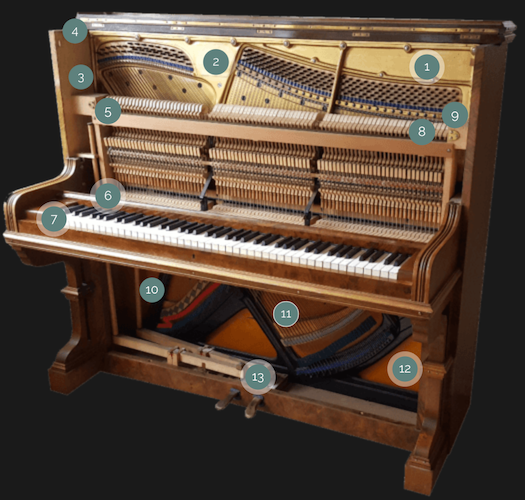SELECT A TOPIC BELOW
Serial Numbers
Serial Numbers are most commonly located inside the top lid of the piano somewhere above the tuning pins (pegs) on the frame. These are used to identify exactly where & when your piano was made. Finding your Piano’s Serial Number may be as simple as lifting the lid, however more obscure serial numbers might only be visible once you’ve removed a couple of panels or inspected with a torch.
Still No Serial Number?
Some pianos have serial numbers that are either too well hidden, difficult to read, or occasionally displaying several number sequences that contradict each other. In these situations a piano expert would determine the piano’s approximate age by the style, design and mechanical construction.

How can I tell which number is the Serial Number?
Some pianos have several numbers displayed which are not all serial numbers. Most commonly serial numbers are a sequence of 4 or more numbers in a row.It’s rare to have a serial number with only 2 or 3 digits however some modern pianos also contain letters as well as numbers or letters only. If there are numbers which contradict each other, select the series of numbers located closest to the frame of the piano.
I Can't Find My Serial Number, Can I still Work Out Its Age?
Unfortunately without a serial number the only real way of finding out your piano’s age is by estimation from a Piano Professional or yourself. If you’re able to estimate an approximate decade in which the piano was made, this would be enough to for our online valuation calculators to work with.
PIANO BRANDS QUESTIONS
Why Isn't My Piano Brand Listed?
The Piano Age Calculator™ provides results for 800+ Brands made over the past 150 years however this application is unable to account for Piano Brands in the following categories:
-
Brands with very limited records or a lack of reliable information.
-
Manufacturers where records have been lost or destroyed through fire or disaster.
-
Smaller Piano Manufacturers where limited numbers( of less than 100) pianos were produced.
-
Pianos Brands that were only made for a very small period of time (less than 5years).
-
Modern brand names built in various locations with non sequential serial numbers or letters
-
Various Brands that have been kept in local regions and not widely distributed.
In terms of the Brand Quality Calculator, this is a more extensive list of over 8000 Piano Brands.
My Piano Brand Listed, How Do I Find Out It's Age?
If your brand is not available here, then it’s highly likely that the serial number records for your piano no longer exists. Our Research team found hundreds of companies with only partial or incomplete records (which we deemed unreliable), as well as over 3,000 manufacturers with records lost, destroyed, or non existent. Unfortunately the only real way of finding out your piano’s age at this point is by estimation from a Piano Professional or Yourself. If you’re able to estimate an approximate decade in which the piano was made, this would be enough to for our online valuation calculators to work with.
How can I find Out More About My Pianos Brand?
Some piano brands have kept detailed records on their manufacturing information and company history, but unfortunately only a handful of companies have this kind of information published. You can try a quick Google Search on your brand, however if that doesn’t provide any further detail you may want to contact a local piano tuner who has access to a “Piano Atlas”.
Is there a way to find out more about my piano’s specific history?
Although some major piano brands around the world have well documented histories, finding out specific details about your piano may prove difficult. Most pianos owners would love to find out:
- Who were the previous owners?
- Where in the world has my piano traveled?
- Has anyone famous played my piano?
- What kind of service history does it have?
Unless your piano has been kept in the family since it was new, answers to these kinds of questions often remain a mystery.
Where Is My Pianos Brand Name Displayed?
Most Brand names are displayed just above the keyboard in the center of the piano where you usually rest your sheet music. If you haven’t managed to locate the brand name here, then you should open the top lid of the piano. Brand names can sometimes be displayed on the frame of the piano or along the internal “action rail”.
PIANO AGE QUESTIONS
How can I figure out my pianos age?
Firstly you’ll need two things, your pianos Brand name and its Serial number which you can use with our Piano Age Calculator. If you don’t have this information OR your Brand is not displayed on this Calculator then you’ll have one of the following two options:
- Estimate your piano’s age – Some pianos provide clear visual clues to help determine it’s age. If you’re just wanting to get a rough estimate, pianos can be categorized
- Modern (Made in the past 30 to 40 years)
- Retro or Vintage (Made in the 40’s, 50’s or 60’s)
- Older (Made early 1900’s to 1930’s)
- Ancient (Made post 1890)
- Pay a Piano Tuner for an onsite inspection – The expert eye of a Piano Tuner can quickly decipher a piano’s age based on its visual design mechanical construction and overall condition.
What if my brand isn't available on the Piano Age Calculator?
The Piano Age Calculator™ provides results for 800+ Brands made over the past 150 years, however this application is unable to account for every single Piano Brand. If your brand is not available here, then it’s highly likely that the serial number records for your piano no longer exists. Our Research team found hundreds of companies with only partial or incomplete records (which we deemed unreliable), as well as over 3,000 manufacturers with records lost, destroyed, or non existent. Unfortunately the only real way of finding out your piano’s age at this point is by estimation from a Piano Professional or Yourself. If you’re able to estimate an approximate decade in which the piano was made, this would be enough to for our online valuation calculators to work with.
VALUATION QUESTIONS
My Piano hasn’t been tuned for a long time, will this affect its value?
A piano which has been neglected from regular servicing can certainly affect the piano’s condition which in turn may reduce its monetary value. However in terms of a piano’s general value, a single piano service won’t necessarily make a significant improvement to it’s condition but would still be worth considering. If you’re planning on selling your piano then having it tuned is certainly a way to make it more desirable for a potential buyer.
Is there a way to increase my piano's potential value?
YES, however these valuable insights are only available with Full Online Access
My Piano is a beautiful furniture piece, would this increase it’s value?
In most cases the visual appearance of a piano is in keeping with its appeal as an instrument and therefore holds no extra monetary value. However, occasionally a piano’s body may have such beauty that it would attract a higher price, or at least a higher buying demand.
Are there some pianos worth more because they are rare or unique?
Sometimes, but very, very rarely!
My Piano has an Iron frame, does this make it more valuable?
No. Almost every single piano made in the last 120 years has been built with an iron frame.
My Piano is really old, is it worth more as an Antique?
No.
Are pianos with Ivory keys worth more than ones with plastic keys?
In most cases, ivory keys are just a normal part of the piano production during a certain period of time. The ivory alone doesn’t directly affect the piano’s value over an equivalent piano with plastic keys. It’s important to note however, when dealing with a high quality older piano, replacing ivory keys with modern glossy white keys can look tacky. Authenticity is a great sign of quality.
What kind of Piano’s don’t you provide valuations for?
We have an exclusive range of valuations calculators that provide results for thousands of pianos brands and types. The only valuations we can’t provide are for Grand Pianos made before 1950 or instruments which have already been fully restored or rebuilt. It’s important to not also that we don’t have specific valuations for Pianola/Player pianos however our data shows that many of these instruments have very simula valuations to its Upright Piano equivalent.
MEMBERSHIP QUESTIONS
What is the cost to Get Online Access?
Will the monthly membership end after 1 month?
Monthly memberships automatically renew, it’s up to you to manually cancel membership when you decide to do so.
How do I cancel my membership?
To cancel your membership you must first logged in.
Once you’ve logged in CLICK HERE to cancel your membership.
If I sign up to unlock access, when does my membership begin?
Membership begins from the moment you sign up and pay.
Can I extend the length of my membership once I’ve paid?
Unfortunately you can’t extend your membership beyond the fixed period. If you require longer, we recommend selecting the monthly membership.
What payment methods are available for membership?
Membership payments can be made securely online with any Visa, Mastercard or American Express credit card.
Expert Piano Valuation Insights
Valuation Mistakes
#1. Basic Comparison
One of the most common mistakes made when valuing pianos is simply comparing two pianos that look similar. Unfortunately the variations between what appear to be almost identical can be huge. Presuming the value of one piano based on the matching look of another piano is a highly inaccurate means of valuation. Even when buying a new Piano, there are dozens of pianos that at a glance ought to be around the same price yet are thousands of dollars difference. When it comes to Pianos, it’s not always easy to compare “apples with apples”
#2. Phone A Friend
A common mistake when looking to find out your piano’s value, is to ask your musical friend or a childs piano teacher. Unfortunately unless your friend is a Professional Piano Valuer or experienced Piano Tuner, it’s difficult to have a realistic idea on what your piano’s worth. Many times pianos can either be massively undervalued due to a lack of knowledge about a specific brand, or on the other hand, told that it’s worth a fortune. Either way it’s better to avoid the disappointment…


#3. Antique Value
Unless you’re familiar with the workings of the piano, it would be easy to presume that pianos almost last forever and that perhaps old pianos are worth more because they’re “Antique”. This is possibly the most common Piano Myth when it comes to piano valuations. Unfortunately Pianos don’t hold any antique value… In fact, pianos are only valued on their worth as an instrument. As a piano ages the mechanical aspects of the piano tend to deteriorate which affects its playability, sensitivity and overall performance.
#4. Sentimental Value
For anyone who’s ever owned a piano for any length of time knows, we get emotionally attached to them. This is especially true for the “family piano”, which for decades or generations has been kept with a deep sense of history and memories within the heart of the instrument. At this point, even a piano that’s literally falling apart feels like it must be worth more than it really is. With regret, a pianos sentimental value is not always transferable into extra dollars.
Piano Valuation Formulas
Calculating your pianos value involves a complex formula of various aspects of your piano. In order to piece together this equation, a Piano Expert would usually ask the following questions:
What Kind Of Piano Is It?
(Upright/Grand, Large or Small) This immediately provides and image of the piano and helps narrow the potential value spectrum.
How old is your Piano?
This is commonly the most telling of every question as to the Pianos potential value.
Has it been serviced recently?
A pianos service history is not always telling of its value, however it may give some indication to its current condition.
What’s the Brand Name?
This can often provide a guide to pianos quality or popularity and demand in the market.
What’s its condition like?
A pianos condition is usually connected closely with it’s age however the older a piano becomes the larger the condition can vary.
How does it sound and feel?
Although this ought to be the most important question, this is generally asked last because many piano owners would describe their piano as ”Beautiful”. A genuine independent analysis of the piano is difficult with personal taste or biases involved.
Our Online Piano Calculators use a series of formulas that combine with existing valuation data to cross reference Pianos that match yours. This unique algorithm uses your tailored input such as your pianos Brand or Quality Rating, its Style & Size along with it’s Age and Condition. Depending on the specific piano, some aspects of the piano have a greater bearing on the valuation outcome. For example the variation in condition of a 5 Year old piano would be only small therefore the valuation formula would give less consideration to it’s condition settings. Whereas the condition for a piano over 100 years would vary greatly and so our formulas would calculate a larger impact on the valuation outcome.
Understanding Your Valuation
Piano Valuations may be required for a whole lot of reasons, but whether you’re buying, selling, restoring or insuring, it’s important to understand the context of your valuation. Just like with any on-site piano valuation, it’s not possible to predict the exact price someone would be willing to pay for the instrument, however it is reasonable to gather an estimated price range. This range is commonly referred to as “Market Value”. To better understand this term in context with your online piano valuation, here’s a guide to explain the contrast between ” Market Value” (which is what our calculations provide) and other valuation types.
MARKET VALUE
Market Value is a term generally used when considering what an Business is worth on the open Market. However here, it is the most common average price range for this piano sold privately.
This valuation presumes there are no extra products, services or taxes included. The valuation does not take into account the cost of the piano bench etc.
Market Value is based on the current conservative value of the piano if sold privately within a localised area.
These Piano valuation ranges are unlike the Market Value of a business, Pianos are rarely affected by local economies and trends.
RETAIL VALUE
Retail Value is a term used when considering the common advertised price for a retail item. This is generally a higher price range than the “Market Value”.
This valuation presumes there would be certain extras included that you’d expect from a retailer. Things like delivery, warranty, after sales service and possible sales tax.
Retail Values can vary significantly based on the individual supplier, location and business costs/profits.
These Prices may occasionally be inflated with short term marketing campaigns or heavily reduced through sales or promotions.
REPLACEMENT VALUE
Replacement Value is a term commonly used when dealing with the insurance value of an item. This is generally higher than the average “Market Value” price range.
This valuation presumes there may be a few extras required to replace the piano. For example, the cost of a piano stool, delivery or other services required.
Replacement Value is based on the potential cost of replacing the piano with a similar piano if purchased from a local Retailer.
This valuation range is usually over inflated to allow for a worthy replacement piano and possible increases in local pricing.